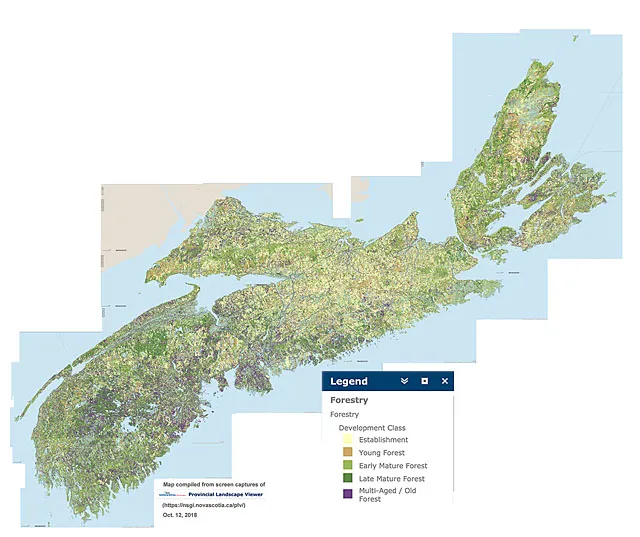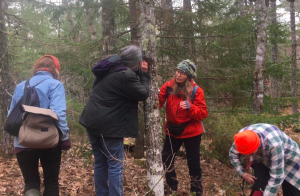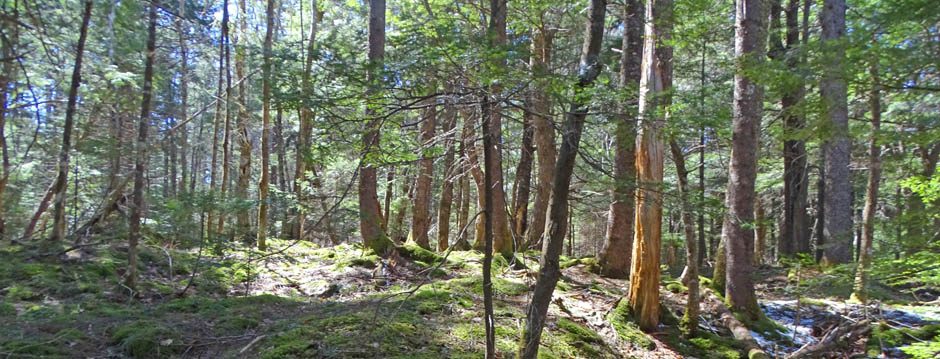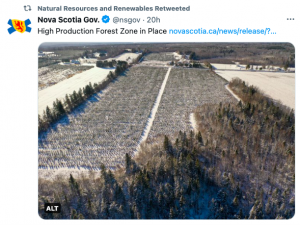The current government deserves credit for moving faster than its predecessor to “implement the Lahey recommendations”. However in regard to Lahey’s directive that protecting ecosystems take priority over all else, the jury is still out.
From Natural Resources and Renewables News Release (italics inserted):
The Province has dedicated a high production forest zone, completing its triad model of ecological forestry.
This will support the economy while ensuring that 90 per cent of Crown land is managed with biodiversity as the top priority.
Ten per cent of Crown land – 185,000 hectares, currently – will be allocated for the high production forest zone where clear-cutting is allowed, as recommended in the review.
Once forestry licensees have harvested an area in this zone, they will prepare and add nutrients to the soil, plant high-quality, fast-growing seedlings and manage the crop for decades. This method of forestry can produce crops of trees that mature in 25 to 40 years, compared with 60 to 90 years through traditional approaches.
High production forestry will be done mainly on Crown lands that have been previously used for forestry or agriculture, are conducive to growing spruce trees quickly and are relatively close to existing sawmills. It will not be done on Crown lands that include or are near parks and protected areas, old growth forests, sensitive habitats, tolerant hardwood or pine forests, special wildlife management zones, buffers along watercourses or areas with high Indigenous cultural value.
Three initial sites totalling about 0.5 per cent of Crown land have been identified. Licensees can now do further work to determine the suitability of these sites, develop harvesting and silviculture proposals and submit them to the Department. Proposals must go through the existing review process, which includes opportunity for the public to submit their local knowledge about sites. More sites will be evaluated and made available until a maximum of 10 per cent is reached.
The conservation zone is currently about 35 per cent of Crown land…The mixed-use zone is currently about 55 per cent of Crown land.
Included in the release: High Production Forestry in Nova Scotia Phase 2 Guidance for Implementation (Jan 2023 document). In Appendix A are maps showing “sites that may be suitable for high production forestry in the first three initial ecodistricts that the department has assessed. Licensees will conduct field verifications to confirm their suitability for high production forestry” “These sites total 9,395 hectares of potentially suitable area to be confirmed by licensees through their field verifications. ..Full implementation of the high production forest zone will take decades. The department estimates that each year for the next 35 years, licensees will establish about 5,000 hectares of Crown land in the zone. ”
COMMENT
This is significant progress, as painfully slow as it has been. We have been through successive PC-NDP-Liberal governments and a PC government again since the province first began to seriously consider fundamental reform of forestry practices in the mid-2000s. Governments of the day – with pressure from Big Forestry – rejected most of the Natural Resources Strategy recommendations (2010/2011) that would have included regulating clearcutting on both Private & Crown lands. (Since then, any significant regulation of Private lands has been taboo.)
Then came the Independent Review of Forestry Practices under Bill Lahey, initiated in September 2017 with his report released on Aug 21, 2018. There was no or little slowdown in harvesting on Crown lands until spring 2022, when under the current PC government, it really began to slow down (although with some ongoing issues, e.g. around harvests at Beals Meadow and more recently at Goldsmith Lake).
On Managing for Biodiversity
The failure to act on promised actions since 2010, following on the decades of unfettered clearcutting beginning in the Stanfield years has cost us dearly biodiversity-wise. One indicator: Old Growth forest likely covered 40-50% of the landscape in pre-Columbian times (Moessler et al., 2003); by 1958, forests 100 years and older were down to 8.7%, and by 1997-2003 to just 0.3% (Figures from Government sources cited in GPI, 2008). It remains in that vicinity today but we have lost additionally much Old Forest (80 years & older) on Crown and Private lands.
The broad pattern of how harvesting has affected our forests in recent years is illustrated by the distribution of darker colours in the map below (focus on purple).

Distribution of forest in 5 development stages across Nova Scotia, compiled from NS Landscape Map Viewer in 2018. Purple = Multi-aged/Old Forest. View larger versions of the map: 2000 px | 4000 px.
(You may have to Save the larger image and open it on your device to view at full size).
In 1958, Central and Northern NS and much of Cape Breton would have had darker colouration equivalent to or greater than that seen in 2018 in SW Nova Scotia; the loss was due to clearcutting from the Standfield years on, in the heyday of Pulp & Paper in NS. The Crown lands and the Bowater Mersey lands (now Crown land) of SW Nova Scotia were much less intensively cut, hence the focus on that area since the advent of the WestFor consortium (and precursors back to 2014).
So that’s more or less where we stand today; Old Forest has been decimated though much of the province except in SW Nova Scotia. There is much less overt clearcutting on Crown lands than 5 years ago, but now even partial cutting is contributing to loss or degradation of remaining Old Forest via “Highgrading at the Landscape Level“.
So what? It always stood to reason that the loss of older forest in NS must have been accompanied by significant losses in biodiversity, and independent wildlife experts/naturalists such as Bob Bancroft said, yes, they had witnessed such declines. However, critical data and analyses were lacking and there has been little to counteract the perhaps equally plausible notion that existing riparian protection, Protected Areas etc. as well as the continued cover of most of the NS landscape by forest of some sort have been sufficient, in general, to protect forest biodiversity.
Thus, for example, in response to concerns about impacts of clearcutting on forest birds, NS Natural Resources experts responded
Bird populations and habitat are impacted by many human activities on the landscape and forestry is not among the most significant source of impacts” compared to cat predation, housing and road development, and vehicle collisions (see NSFN June 8, 2018).
That sort of perspective is pervasive amongst the professional forestry community in Canada including the Private and Government sectors which likes to cite the very low rate of Deforestation (complete loss of forest/conversion to other uses) as evidence of our “sustainable forest practices” in Canada, while ignoring the effects of “Forest Degradation” associated with clearcutting/loss of older forests, fragmentation by forestry roads etc.
That story all came to an end or we hope has come to en end with the publication of Forest degradation drives widespread avian habitat and population declines by MG Betts et al., 2022. This “2022 Bird Study” (my shorthand for it), published in a top scientific journal and headed by Matt Betts, a prof. at Oregon State University and a New Brunswicker by birth, was based on data for the Maritime Provinces.
In a nutshell, this is what it showed:
Overall, our results indicate that forest degradation has led to habitat declines for the majority of forest bird species with negative consequences for bird populations, particularly species associated with older forest. Forest changes include conversion from mixed-species forests to single-species conifer-dominated plantations or thinnings and clear-cutting old forests without equivalent regrowth into old age classes
The authors were well aware of the implications.
If maintaining non-declining populations of forest birds is the goal, conservation measures that halt the alteration of habitat, particularly in diverse, older forests, will be necessary.
Of course, this may come at the expense of wood production but potentially less so with forest-landscape zoning that maintains reserves, ecological forestry and spatially limited intensive management.
So yes, potentially we could reverse the losses in biodiversity in NS, and we have taken the first steps. The critical question is: Will the implementation of the Triad actually result in a reversal of the trend of loss and fragmentation of Old Forest on Crown lands?
We (the public) simply don’t know. The Government/NRR must have the data and models that allow them to predict the impacts of further harvesting on loss and perhaps also, fragmentation of Old Forest on Crown land and to come up with a scheme that not only stops such losses but allows these Old Forests to begin to recover. To give credibility to the claim that “90 per cent of Crown land is [now] managed with biodiversity as the top priority”, those numbers and the long term plans must be made public.

Citizen Scientists conduct lichen survey at Beals Meadow in spring of 2022
I suggest it’s important to remember that we are talking only about Crown lands. As successive NS governments have steered away from further regulation of private land forestry to protect biodiversity, that places more onus on managing the public, Crown lands to protect forest biodiversity in NS. And that’s what Nova Scotians expect but do not take for granted (re, for example, AP068499 Beals Meadow)
On the public processes for reviewing ‘harvest proposals’
From the News Release: “Proposals must go through the existing review process, which includes opportunity for the public to submit their local knowledge about sites. More sites will be evaluated and made available until a maximum of 10 per cent is reached.”
This seems to imply that there is no long-term planning of what should be allowed to be cut and when on Crown lands, that it is all done piece-meal as industry makes a single proposal and it is reviewed, giving the public 40 days to respond etc. as has occurred in recent years.
Whatever happened to the elusive but presumably still-in-the cards Environmental Assessment, which includes “20-year forest stewardship plans”? To date, that’s the only indication that some landscape level planning for biodiversity conservation could be part of the whole process, but details have been lacking.
From the current description on the NS Government Ecological Forestry website : “A new framework is being developed that will support the review of Crown land forest stewardship plans submitted by applicable Crown forest agreement holders either as a Class II Environmental Assessment under the Environment Act or in a process that is similar to the Class II process. Government has engaged NorthWinds Environmental Services to develop a guide for the preparation of 20-year forest stewardship plans.”
To conclude
The current government deserves credit for moving faster than its predecessor to “implement the Lahey recommendations”. However in regard to Lahey’s directive that protecting ecosystems take priority over all else, the jury is still out.
In other words, I have concluded that protecting ecosystems and biodiversity should not be balanced against other objectives and values as if they were of equal weight or importance to those other objectives or values. Instead, protecting and enhancing ecosystems should be the objective (the outcome) of how we balance environmental, social, and economic objectives and values in practising forestry in Nova Scotia. – William Lahey, Aug 2018
From CBC
Province releases Crown land locations where clear cutting may soon be permitted
Frances Willick · CBC News “Raymond Plourde, wilderness co-ordinator with the Ecology Action Centre, said he would rather not see any herbicides applied to Crown lands, and any research that helps reduce spraying of herbicides is a good thing.
Plourde said he’s glad to see the province commit to a 10 per cent cap on high-production forestry on Crown land, and that the selection criteria for the parcels seem well conceived.He hopes the province will now turn its attention to selecting areas of Crown land that will receive protection and help achieve the goal of 20 per cent protected land and water by 2030. Currently, about 13 per cent of Nova Scotia’s land and water is protected.”
Industry reacts
In a news release, the province notes that using high-production forestry methods will allow crops of trees to mature in 25 to 40 years, compared with 60 to 90 years using traditional practices. … Stephen Moore, the executive director of Forest Nova Scotia, which represents companies operating in the lumber and forestry sector, said that timeline is a concern. “Seeing that it’s going to take more than three decades to get to the full level of high-production forestry is a bit of a disappointment, but we do believe we have room to work with the government to try to speed that timeline up.””
Some Related Posts
On Reversing Forest Degradation in Nova Scotia
Post on NSFN, June 8, 2022
What’s left to do to implement the Forest Triad in Nova Scotia by 2023? Plenty 13Jul2022
Post on versicolor.ca/nstriad July 13, 2022
Draft Nova Scotia Forestry EA Process surfaces 21May2021
Post on NSFN, May 21, 2021 “It appears Talk and Log will continue for another four years after the Lahey Recommendations are implemented”
Biodiversity Landscape Planning for Nova Scotia is being developed as part of the L&F Environmental Assessment Project 16Jun2020
Post on NSFN, June 16, 2020
Assessment of Progress on Environmental Assessment Project
In a post on NSFN, Sep 8, 2020.
————-
Additional Resources cited in the NRR News Release
High Production Forestry Phase 1 – Final Report: https://novascotia.ca/ecological-forestry/docs/HPF-phase1-report.pdf
High Production Forestry Phase 2 – Guidance for Implementation: https://novascotia.ca/ecological-forestry/docs/HPF-phase2-guidance-for-implementation.pdf
Ecological forestry approach: https://novascotia.ca/ecological-forestry/
Natural Resources and Renewables on Twitter: https://twitter.com/NS_DNRR

